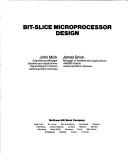| Listing 1 - 10 of 14 | << page >> |
Sort by
|
Book
ISBN: 0003830675 Year: 1986 Publisher: London : Collins,
Abstract | Keywords | Export | Availability | Bookmark
 Loading...
Loading...Choose an application
- Reference Manager
- EndNote
- RefWorks (Direct export to RefWorks)

ISBN: 0824071034 Year: 1981 Publisher: New York (N.Y.) : Garland STPM press,
Abstract | Keywords | Export | Availability | Bookmark
 Loading...
Loading...Choose an application
- Reference Manager
- EndNote
- RefWorks (Direct export to RefWorks)

ISBN: 0070417814 Year: 1980 Publisher: New York (N.Y.) MacGraw-Hill
Abstract | Keywords | Export | Availability | Bookmark
 Loading...
Loading...Choose an application
- Reference Manager
- EndNote
- RefWorks (Direct export to RefWorks)
Electronics --- Computer architecture. Operating systems --- Bit slice microprocessors --- -681.3*C53 --- #TELE:d.d. Prof. A. J. J. Oosterlinck --- 681.3-181.48 --- Microprocessoren --- microprocessoren --- computerarchitectuur --- Microprocessors --- Semiconductors --- Design and construction --- Microcomputers: microprocessors (Computer system implementation) --- Design and construction. --- 681.3*C53 Microcomputers: microprocessors (Computer system implementation) --- Microprocesseurs en tranches --- Conception et construction --- 681.3*C53

ISBN: 1282355732 9786612355738 0520910427 9780520910423 0520068505 0520071166 9780520068506 Year: 1990 Publisher: CA University of California Press
Abstract | Keywords | Export | Availability | Bookmark
 Loading...
Loading...Choose an application
- Reference Manager
- EndNote
- RefWorks (Direct export to RefWorks)
An early cameo of Latin American surrealism, Rosamel del Valle's erotic narrative of ecstasy and perdition creates the rhythm of the dream and the tempo of madness. Intermittently a waiflike young woman, Eva, intrudes into the daily routine of the writer. Her appearances are marked by a circle of red and the vision of a deep well with a star hanging over it. A tone poem of surrealist encounter, pursuit, and loss, Eva y la Fuga was written in 1930 and finally published posthumously in 1970, by Monte Avila Press in Venezuela. Anna Balakian offers here the first translation of the work into any other language. She brilliantly conveys in English the author's highly metaphoric language and the immediacy of surrealist experience, signaled in the narrative by frequent lapses into a haunting present tense.On their walks through the streets of Santiago, Eva and the narrator mingle in the fiesta atmosphere of the Chilean Amusement Park, with its gigantic Ferris Wheel. Bits of real-life dialogue float through the air. But the couple move on different wavelengths from the crowd and often from each other. Passing in and out of his life, Eva exercises a hypnotic fascination over the writer and makes an equally profound impression on the reader. This narrative is in the same genre as Gerard de Nerval's Aurélia, André Breton's Nadja, and Michel Leiris's Aurora, and should be counted among the most compelling works of twentieth-century surrealist literature.
Chilean literature --- 20th century. --- 1930s. --- art history. --- art movements. --- author. --- daily life. --- day to day. --- dreamlike. --- ecstasy. --- erotic. --- ferris wheel. --- figurative language. --- grief. --- latin america. --- latin american. --- lesser known. --- literary movements. --- loss. --- mental health. --- metaphors. --- poetry. --- posthumous. --- santiago. --- slice of life. --- surrealism. --- tone poem. --- translation. --- writer. --- young woman. --- Amusement parks --- Courtship --- Loss (Psychology)
Book
ISBN: 3038979651 3038979643 Year: 2019 Publisher: MDPI - Multidisciplinary Digital Publishing Institute
Abstract | Keywords | Export | Availability | Bookmark
 Loading...
Loading...Choose an application
- Reference Manager
- EndNote
- RefWorks (Direct export to RefWorks)
The present Special Issue collects a number of new contributions both at the theoretical level and in terms of applications in the areas of nonparametric and semiparametric econometric methods. In particular, this collection of papers that cover areas such as developments in local smoothing techniques, splines, series estimators, and wavelets will add to the existing rich literature on these subjects and enhance our ability to use data to test economic hypotheses in a variety of fields, such as financial economics, microeconomics, macroeconomics, labor economics, and economic growth, to name a few.
discrete duration models --- volatility feedback effect --- semiparametric estimation --- nonparametric method --- GLS detrending --- functional coefficients --- purified implied volatility --- country competitiveness index --- nonparametric frontiers --- efficiency --- materials balance condition --- panel data --- Dirichlet process prior --- classification --- indicators --- Kendall’s tau --- realised volatility --- Malmquist productivity index --- conditional dependence index --- wavelet --- dependent Bayesian nonparametrics --- TFP growth --- Solow economic growth convergence model --- unit root testing --- nonparametric 2SLS estimator --- random forests --- competitiveness --- slice sampling --- integrated difference kernel estimator --- maximum score estimator --- heterogeneous autoregressive model --- generalized additive models --- Monte Carlo --- tensor products --- cubic spline penalty --- M-estimation --- nonparametric copula --- leverage effect --- conditional quantile function --- emissions --- efficient semiparamteric estimation --- DEA --- tail dependence index --- difference kernel estimator --- nonparametric threshold regression --- machine learning --- factors --- local linear regression --- European Union --- financial development --- series estimator --- production efficiency
Book
Year: 2021 Publisher: Basel, Switzerland MDPI - Multidisciplinary Digital Publishing Institute
Abstract | Keywords | Export | Availability | Bookmark
 Loading...
Loading...Choose an application
- Reference Manager
- EndNote
- RefWorks (Direct export to RefWorks)
In the early years of life, the environments that interact with a child—including families, schools, and communities—play a key role in the child’s brain development. Early child development and overall children’s developmental trajectories have long-term implications for health, happiness, and earning potential as these children become adults. Importantly, failing to reach developmental potential contributes to global cycles of poverty, inequality, and social exclusion. There is little public understanding of the importance of a child’s first years and the critical developmental opportunity to reach optimal functioning. As such, global data on early child developments are crucial to inform the public and demand evidence-based policies and high-quality programs for children around the world. This book includes initiatives assessing the impact of programs and interventions related to children’s health, education, and participation that inform evidence-based policies worldwide. Importantly, this book raises global awareness of the importance of children’s first years of life and the crucial role of child–environment interactions where the child lives, plays, and grows. The culturally diverse content comprises international representation of studies and classifications tools. International experts contributed high-quality reviews that collate valuable information and guide the adoption of a rights-based approach in early child development globally.
Humanities --- Social interaction --- child development --- motor skills --- vision disorders --- evaluation --- physical therapy --- optometry --- congenital Zika syndrome --- user participation --- mobility --- intervention --- child vocabulary --- maternal mental health --- Peru --- routines --- intervention planning --- collaborative consultation --- international --- implementation --- developmental delay --- child health --- birth weight --- growth measurement --- responsive caregiving --- parent–child interaction --- observational measurement --- thin slice methodology --- low- and middle-income countries --- Brazil --- functioning --- outcomes --- education --- measurement --- child development assessment --- academic achievement --- educational attainment --- wealth/socioeconomic status --- COVID-19 --- participation --- Routines-Based Model --- family-centered --- child --- pandemic --- teleintervention --- abilities --- rights --- children with cerebral palsy --- agreement --- stability --- communication function classification system --- early child development --- ICF --- health --- inequality --- potential --- disability --- absent learners --- biological mothers --- first 1000 days --- Foundation phase --- Early Development Instrument --- developmental health --- social determinants of health --- autism spectrum disorder --- measure --- assessment --- complex communication needs --- severe physical disabilities --- eye-gaze controlled computer --- communicative interaction --- n/a --- indicators --- global health --- validation --- cross-cultural --- cross-linguistic --- parent-child interaction
Book
Year: 2021 Publisher: Basel, Switzerland MDPI - Multidisciplinary Digital Publishing Institute
Abstract | Keywords | Export | Availability | Bookmark
 Loading...
Loading...Choose an application
- Reference Manager
- EndNote
- RefWorks (Direct export to RefWorks)
In the early years of life, the environments that interact with a child—including families, schools, and communities—play a key role in the child’s brain development. Early child development and overall children’s developmental trajectories have long-term implications for health, happiness, and earning potential as these children become adults. Importantly, failing to reach developmental potential contributes to global cycles of poverty, inequality, and social exclusion. There is little public understanding of the importance of a child’s first years and the critical developmental opportunity to reach optimal functioning. As such, global data on early child developments are crucial to inform the public and demand evidence-based policies and high-quality programs for children around the world. This book includes initiatives assessing the impact of programs and interventions related to children’s health, education, and participation that inform evidence-based policies worldwide. Importantly, this book raises global awareness of the importance of children’s first years of life and the crucial role of child–environment interactions where the child lives, plays, and grows. The culturally diverse content comprises international representation of studies and classifications tools. International experts contributed high-quality reviews that collate valuable information and guide the adoption of a rights-based approach in early child development globally.
child development --- motor skills --- vision disorders --- evaluation --- physical therapy --- optometry --- congenital Zika syndrome --- user participation --- mobility --- intervention --- child vocabulary --- maternal mental health --- Peru --- routines --- intervention planning --- collaborative consultation --- international --- implementation --- developmental delay --- child health --- birth weight --- growth measurement --- responsive caregiving --- parent–child interaction --- observational measurement --- thin slice methodology --- low- and middle-income countries --- Brazil --- functioning --- outcomes --- education --- measurement --- child development assessment --- academic achievement --- educational attainment --- wealth/socioeconomic status --- COVID-19 --- participation --- Routines-Based Model --- family-centered --- child --- pandemic --- teleintervention --- abilities --- rights --- children with cerebral palsy --- agreement --- stability --- communication function classification system --- early child development --- ICF --- health --- inequality --- potential --- disability --- absent learners --- biological mothers --- first 1000 days --- Foundation phase --- Early Development Instrument --- developmental health --- social determinants of health --- autism spectrum disorder --- measure --- assessment --- complex communication needs --- severe physical disabilities --- eye-gaze controlled computer --- communicative interaction --- n/a --- indicators --- global health --- validation --- cross-cultural --- cross-linguistic --- parent-child interaction
Book
Year: 2021 Publisher: Basel, Switzerland MDPI - Multidisciplinary Digital Publishing Institute
Abstract | Keywords | Export | Availability | Bookmark
 Loading...
Loading...Choose an application
- Reference Manager
- EndNote
- RefWorks (Direct export to RefWorks)
In the early years of life, the environments that interact with a child—including families, schools, and communities—play a key role in the child’s brain development. Early child development and overall children’s developmental trajectories have long-term implications for health, happiness, and earning potential as these children become adults. Importantly, failing to reach developmental potential contributes to global cycles of poverty, inequality, and social exclusion. There is little public understanding of the importance of a child’s first years and the critical developmental opportunity to reach optimal functioning. As such, global data on early child developments are crucial to inform the public and demand evidence-based policies and high-quality programs for children around the world. This book includes initiatives assessing the impact of programs and interventions related to children’s health, education, and participation that inform evidence-based policies worldwide. Importantly, this book raises global awareness of the importance of children’s first years of life and the crucial role of child–environment interactions where the child lives, plays, and grows. The culturally diverse content comprises international representation of studies and classifications tools. International experts contributed high-quality reviews that collate valuable information and guide the adoption of a rights-based approach in early child development globally.
Humanities --- Social interaction --- child development --- motor skills --- vision disorders --- evaluation --- physical therapy --- optometry --- congenital Zika syndrome --- user participation --- mobility --- intervention --- child vocabulary --- maternal mental health --- Peru --- routines --- intervention planning --- collaborative consultation --- international --- implementation --- developmental delay --- child health --- birth weight --- growth measurement --- responsive caregiving --- parent-child interaction --- observational measurement --- thin slice methodology --- low- and middle-income countries --- Brazil --- functioning --- outcomes --- education --- measurement --- child development assessment --- academic achievement --- educational attainment --- wealth/socioeconomic status --- COVID-19 --- participation --- Routines-Based Model --- family-centered --- child --- pandemic --- teleintervention --- abilities --- rights --- children with cerebral palsy --- agreement --- stability --- communication function classification system --- early child development --- ICF --- health --- inequality --- potential --- disability --- absent learners --- biological mothers --- first 1000 days --- Foundation phase --- Early Development Instrument --- developmental health --- social determinants of health --- autism spectrum disorder --- measure --- assessment --- complex communication needs --- severe physical disabilities --- eye-gaze controlled computer --- communicative interaction --- indicators --- global health --- validation --- cross-cultural --- cross-linguistic --- child development --- motor skills --- vision disorders --- evaluation --- physical therapy --- optometry --- congenital Zika syndrome --- user participation --- mobility --- intervention --- child vocabulary --- maternal mental health --- Peru --- routines --- intervention planning --- collaborative consultation --- international --- implementation --- developmental delay --- child health --- birth weight --- growth measurement --- responsive caregiving --- parent-child interaction --- observational measurement --- thin slice methodology --- low- and middle-income countries --- Brazil --- functioning --- outcomes --- education --- measurement --- child development assessment --- academic achievement --- educational attainment --- wealth/socioeconomic status --- COVID-19 --- participation --- Routines-Based Model --- family-centered --- child --- pandemic --- teleintervention --- abilities --- rights --- children with cerebral palsy --- agreement --- stability --- communication function classification system --- early child development --- ICF --- health --- inequality --- potential --- disability --- absent learners --- biological mothers --- first 1000 days --- Foundation phase --- Early Development Instrument --- developmental health --- social determinants of health --- autism spectrum disorder --- measure --- assessment --- complex communication needs --- severe physical disabilities --- eye-gaze controlled computer --- communicative interaction --- indicators --- global health --- validation --- cross-cultural --- cross-linguistic
Book
Year: 2021 Publisher: Basel, Switzerland MDPI - Multidisciplinary Digital Publishing Institute
Abstract | Keywords | Export | Availability | Bookmark
 Loading...
Loading...Choose an application
- Reference Manager
- EndNote
- RefWorks (Direct export to RefWorks)
Dear Colleagues, The brain is vulnerable to injury. Following injury in the brain, apoptosis or necrosis may occur easily, leading to various functional disabilities. Neuronal death is associated with a number of neurological disorders including hypoxic ischemia, epileptic seizures, and neurodegenerative diseases. The brain subjected to injury is regarded to be responsible for the alterations in neurotransmission processes, resulting in functional changes. Oxidative stress produced by reactive oxygen species has been shown to be related to the death of neurons in traumatic injury, stroke, and neurodegenerative diseases. Therefore, scavenging or decreasing free radicals may be crucial for preventing neural tissues from harmful adversities in the brain. Neurotrophic factors, bioactive compounds, dietary nutrients, or cell engineering may ameliorate the pathological processes related to neuronal death or neurodegeneration and appear beneficial for improving neuroprotection. As a result of neuronal death or neuroprotection, the brain undergoes activity-dependent long-lasting changes in synaptic transmission, which is also known as functional plasticity. Neuroprotection implying the rescue from neuronal death is now becoming one of global health concerns. This Special Issue attempts to explore the recent advances in neuroprotection related to the brain. This Special Issue welcomes original research or review papers demonstrating the mechanisms of neuroprotection against brain injury using in vivo or in vitro models of animals as well as in clinical settings. The issues in a paper should be supported by sufficient data or evidence. Prof. Bae Hwan Lee Guest Editor
Research & information: general --- global cerebral ischemia --- amiloride --- sodium-hydrogen exchanger-1 --- zinc --- neuronal death --- neuroprotection --- neurodegenerative disorder --- choline acetyltransferase (ChAT) --- trimethyltin (TMT) --- bean phosphatidylserine (Bean-PS) --- brain-derived neurotrophic factor --- moderate hypoxia --- physical exercise --- psychomotor function --- reaction time --- cortisol --- catecholamines --- nitrite --- endotheline-1 --- lactate --- pyridoxine deficiency --- ischemia --- gerbil --- homocysteine --- cell death --- glia --- neurogenesis --- N-acetyl-l-cysteine --- transient receptor potential melastatin 2 --- neurodegeneration --- Alzheimer's disease --- metabolic disease --- adiponectin --- insulin --- antioxidants --- stroke --- preventive gene therapy --- adenoviral vector --- VEGF --- GDNF --- NCAM --- human umbilical cord blood mononuclear cells --- antioxidant --- brain --- neurodegenerative disease --- oxidative stress --- PGC-1α --- vascular endothelial growth factor --- vascular endothelial growth factor receptor 2 --- PI3K/AKT --- MEK/ERK --- status epilepticus --- hippocampus --- middle cerebral artery occlusion --- reperfusion injury --- lipid emulsion --- excitotoxicity --- apoptosis --- GPR4 receptor --- MPP+ --- Parkinson's disease --- CRISPR/cas9 --- ischemic stroke --- blood brain barrier --- nanoparticle-based drug delivery --- brain targeting --- BDNF --- miRNAs --- synaptic plasticity --- depression --- glioblastoma --- astrocytes --- astrocytic networks --- connexin 43 --- calcium activity --- neural injury --- nimodipine --- subarachnoid haemorrhage --- acid-sensing ion channels --- oxygen-glucose deprivation --- liver growth factor --- inflammation --- microglia --- Tg2576 transgenic mice --- amyloid-beta --- oculomotor system --- trophic factors --- motoneurons --- axotomy --- amyotrophic lateral sclerosis --- electroneutral transport --- cation-chloride cotransporters --- KCCs --- NKCCs --- WNK-SPAK/OSR1 --- ascorbic acid --- aging --- organotypic hippocampal slice culture --- global cerebral ischemia --- amiloride --- sodium-hydrogen exchanger-1 --- zinc --- neuronal death --- neuroprotection --- neurodegenerative disorder --- choline acetyltransferase (ChAT) --- trimethyltin (TMT) --- bean phosphatidylserine (Bean-PS) --- brain-derived neurotrophic factor --- moderate hypoxia --- physical exercise --- psychomotor function --- reaction time --- cortisol --- catecholamines --- nitrite --- endotheline-1 --- lactate --- pyridoxine deficiency --- ischemia --- gerbil --- homocysteine --- cell death --- glia --- neurogenesis --- N-acetyl-l-cysteine --- transient receptor potential melastatin 2 --- neurodegeneration --- Alzheimer's disease --- metabolic disease --- adiponectin --- insulin --- antioxidants --- stroke --- preventive gene therapy --- adenoviral vector --- VEGF --- GDNF --- NCAM --- human umbilical cord blood mononuclear cells --- antioxidant --- brain --- neurodegenerative disease --- oxidative stress --- PGC-1α --- vascular endothelial growth factor --- vascular endothelial growth factor receptor 2 --- PI3K/AKT --- MEK/ERK --- status epilepticus --- hippocampus --- middle cerebral artery occlusion --- reperfusion injury --- lipid emulsion --- excitotoxicity --- apoptosis --- GPR4 receptor --- MPP+ --- Parkinson's disease --- CRISPR/cas9 --- ischemic stroke --- blood brain barrier --- nanoparticle-based drug delivery --- brain targeting --- BDNF --- miRNAs --- synaptic plasticity --- depression --- glioblastoma --- astrocytes --- astrocytic networks --- connexin 43 --- calcium activity --- neural injury --- nimodipine --- subarachnoid haemorrhage --- acid-sensing ion channels --- oxygen-glucose deprivation --- liver growth factor --- inflammation --- microglia --- Tg2576 transgenic mice --- amyloid-beta --- oculomotor system --- trophic factors --- motoneurons --- axotomy --- amyotrophic lateral sclerosis --- electroneutral transport --- cation-chloride cotransporters --- KCCs --- NKCCs --- WNK-SPAK/OSR1 --- ascorbic acid --- aging --- organotypic hippocampal slice culture

ISBN: 0691084343 0691084351 1400882133 9780691084343 Year: 1987 Volume: 115 Publisher: Princeton : Princeton University Press,
Abstract | Keywords | Export | Availability | Bookmark
 Loading...
Loading...Choose an application
- Reference Manager
- EndNote
- RefWorks (Direct export to RefWorks)
On Knots is a journey through the theory of knots, starting from the simplest combinatorial ideas--ideas arising from the representation of weaving patterns. From this beginning, topological invariants are constructed directly: first linking numbers, then the Conway polynomial and skein theory. This paves the way for later discussion of the recently discovered Jones and generalized polynomials. The central chapter, Chapter Six, is a miscellany of topics and recreations. Here the reader will find the quaternions and the belt trick, a devilish rope trick, Alhambra mosaics, Fibonacci trees, the topology of DNA, and the author's geometric interpretation of the generalized Jones Polynomial.Then come branched covering spaces, the Alexander polynomial, signature theorems, the work of Casson and Gordon on slice knots, and a chapter on knots and algebraic singularities.The book concludes with an appendix about generalized polynomials.
Knot theory --- Knots (Topology) --- Low-dimensional topology --- Knot theory. --- Algebraic topology --- 3-sphere. --- Addition theorem. --- Addition. --- Alexander polynomial. --- Algebraic variety. --- Algorithm. --- Ambient isotopy. --- Arf invariant. --- Basepoint. --- Bijection. --- Bilinear form. --- Borromean rings. --- Bracket polynomial. --- Braid group. --- Branched covering. --- Chiral knot. --- Chromatic polynomial. --- Cobordism. --- Codimension. --- Combination. --- Combinatorics. --- Complex analysis. --- Concentric. --- Conjecture. --- Connected sum. --- Conway polynomial (finite fields). --- Counting. --- Covering space. --- Cyclic group. --- Dense set. --- Determinant. --- Diagram (category theory). --- Diffeomorphism. --- Dimension. --- Disjoint union. --- Disk (mathematics). --- Dual graph. --- Elementary algebra. --- Embedding. --- Enumeration. --- Existential quantification. --- Exotic sphere. --- Fibration. --- Formal power series. --- Fundamental group. --- Geometric topology. --- Geometry and topology. --- Geometry. --- Group action. --- Homotopy. --- Integer. --- Intersection form (4-manifold). --- Isolated singularity. --- Jones polynomial. --- Knot complement. --- Knot group. --- Laws of Form. --- Lens space. --- Linking number. --- Manifold. --- Module (mathematics). --- Morwen Thistlethwaite. --- Normal bundle. --- Notation. --- Obstruction theory. --- Operator algebra. --- Pairing. --- Parity (mathematics). --- Partition function (mathematics). --- Planar graph. --- Point at infinity. --- Polynomial ring. --- Polynomial. --- Quantity. --- Rectangle. --- Reidemeister move. --- Remainder. --- Root of unity. --- Saddle point. --- Seifert surface. --- Singularity theory. --- Slice knot. --- Special case. --- Statistical mechanics. --- Substructure. --- Summation. --- Symmetry. --- Theorem. --- Three-dimensional space (mathematics). --- Topological space. --- Torus knot. --- Trefoil knot. --- Tubular neighborhood. --- Underpinning. --- Unknot. --- Variable (mathematics). --- Whitehead link. --- Wild knot. --- Writhe. --- Variétés topologiques --- Topologie combinatoire --- Theorie des noeuds
| Listing 1 - 10 of 14 | << page >> |
Sort by
|

 Search
Search Feedback
Feedback About UniCat
About UniCat  Help
Help News
News